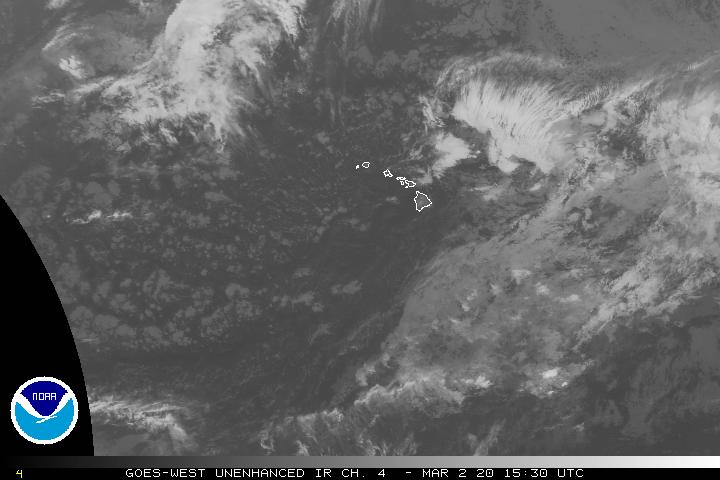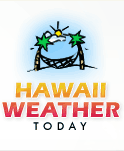Air Temperatures – The following high temperatures (F) were recorded across the state of Hawaii Wednesday…along with the low temperatures Wednesday:
78 – 72 Lihue, Kauai
83 – 69 Honolulu, Oahu
79 – 65 Molokai
80 – 67 Kahului AP, Maui
81 – 65 Kailua Kona
80 – 62 Hilo AP, Hawaii
Here are the latest 24-hour precipitation totals (inches) for each of the islands Wednesday evening:
0.08 Mount Waialeale, Kauai
0.01 Kahuku, Oahu
0.00 Molokai
0.00 Lanai
0.00 Kahoolawe
0.00 Maui
0.01 South Point, Big Island
The following numbers represent the strongest wind gusts (mph) Wednesday evening:
29 Port Allen, Kauai
30 Oahu Forest NWR, Oahu
22 Molokai
32 Lanai
31 Kahoolawe
30 Maalaea Bay, Maui
31 Kealakomo, Big Island
Hawaii’s Mountains – Here’s a link to the live webcam on the summit of our tallest mountain Mauna Kea (nearly 13,800 feet high) on the Big Island of Hawaii. Here’s the webcam for the Haleakala Crater on Maui. These webcams are available during the daylight hours here in the islands, and at night whenever there’s a big moon shining down. Also, at night you will be able to see the stars — and the sunrise and sunset too — depending upon weather conditions.
Aloha Paragraphs

Large high pressure system north…storm low far northwest

High cirrus northwest and northeast

Clear to partly cloudy…some cloudy areas

A few showers – Looping image
~~~ Hawaii Weather Narrative ~~~
Small Craft Advisory…Maalaea Bay, Pailolo and Alenuihaha Channels, Big Island leeward and southeast waters
Wind Advisory…south and north Big Island, east Kohala
Broad Brush Overview: The current trade wind pattern will hold through Friday, as high pressure prevails over the state. A slight increase in moisture over the upcoming weekend may lead to better windward shower coverage, with moderate to breezy trades continuing. A pattern shift is possible next week as a cold front and upper trough approach the area.
Details: The abundance of dry air and deep layer ridging continue to limit shower development. Any showers that do develop will be brief with minimal accumulations across the board. This trend is expected to continue through Friday with the moderate to breezy trades remaining active. The models are suggesting a slight increase in moisture arriving with the trades during the weekend…mostly affecting the windward sides.
Looking Further Ahead: The models go on to point out a pattern change, as a trough of low pressure, and its attendant cold front approach and move into the island chain around the middle of next week. This is a long ways out however, and this idea may need to be altered or scraped altogether…stay tuned as additional model runs work out the details.
Here’s a wind profile of the Pacific Ocean – Closer view of the islands / Here’s the vog forecast animation / Here’s the latest weather map
Marine environment details: The current northwest swell will continue to slowly lower. The next swell is due to arrive Friday night, peak Saturday afternoon and evening, then start fading slowly Sunday. The size of this swell is slightly larger than the current diminishing swell. A High Surf Advisory is likely for most of the islands exposed to this swell. There could be blockage from Kauai, resulting in smaller surf for Oahu’s north and west shores. Although by the same token, it also means potential high surf for the Big Island’s Kona coast. A moderate size northwest swell is due in next Monday night and Tuesday.
World-wide Tropical Cyclone activity
>>> Here’s the latest PDC Weather Wall Presentation, covering Tropical Cyclone 03S (Ava) in the South Indian Ocean…and Tropical Cyclone 01W (Bolaven) is moving towards Vietnam
![]()
>>> Atlantic Ocean:
>>> Caribbean Sea:
>>> Gulf of Mexico:
Here’s a satellite image of the Caribbean Sea…and the Gulf of Mexico
Here’s the link to the National Hurricane Center (NHC)
>>> Eastern Pacific:
Here’s a wide satellite image that covers the entire area between Mexico, out through the central Pacific…to the International Dateline.
Here’s the link to the National Hurricane Center (NHC)
>>> Central Pacific:
Here’s a link to the Central Pacific Hurricane Center (CPHC)
>>> Northwest Pacific Ocean:
Tropical Depression 01W (Bolaven) – Final Warning
JTWC textual forecast warning
JTWC graphical track map
NOAA satellite image
>>> North and South Indian Oceans / Arabian Sea:
Tropical Depression 03S (Ava)
JTWC textual forecast warning
JTWC graphical track map
NOAA satellite image
Here’s a link to the Joint Typhoon Warning Center (JTWC)
Interesting: Lightning Deaths Hit a Record Low in 2017 – Deaths from from lightning strikes hit a record low in 2017 in the United States, according to a new report.
There were 16 lightning-related fatalities in 2017, breaking the previous low of 23 deaths in 2013, according to the National Weather Service (NWS). The records go back to the 1940s, when farmers using tractors and other farm equipment made up a large proportion of the 200 to 400 people who died from lightning every year.
“While we don’t like to see any lightning deaths, the continuing downward trend in yearly fatalities is encouraging,” John Jensenius, a NSW lightning safety specialist, told reporters in an email.
With five deaths, Florida had the most lightning-related fatalities, followed by Alabama (three), and Colorado, Texas and North Carolina (two each). Ohio and Puerto Rico each had one lightning-related death.
The year 2017 also set a record for fewest U.S. male deaths (15) and female deaths (one) from lightning in a year. The victims’ ages ranged from 0 to 82, although six of the fatalities were in ages from 30 to 39, Jensenius said.
Half of the people were doing recreational activities outside — including walking on the beach, horseback riding, fishing, boating, camping and golfing — before lightning struck them. July was the deadliest month, with eight lightning-related fatalities, followed by August, which had three.
An analysis of lightning victims from 2006 to 2016 showed that 352 people were struck and killed by lighting in the United States, including 39 in 2016.
“The common belief that golfers are responsible for the greatest number of lightning deaths was shown to be a myth,” Jensenius wrote in a report, noting that in the same period, from 2006 to 2016, in which lightning killed nine golfers, it claimed the lives of 33 fishermen, 20 people on the beach, 18 campers, 16 boaters and 12 soccer players.
The NWS lightning safety education and awareness program, which started in 2001, has “undoubtedly contributed to the reduction in U.S. lightning fatalities,” Jensenius told reporters. What’s more, cardiopulmonary resuscitation (CPR) and automatic external defibrillators (AEDs) have saved the lives of people hit by lightning.
However, many lightning survivors report having lifelong problems, including memory issues. “Oftentimes, they have trouble remembering old things, or storing new information and then recalling that information













 Email Glenn James:
Email Glenn James:
Helen Says:
It is a crisp winter’s day upcountry-for me at least ! It has just gotten up to 50 on the lanai!
~~~ Hi Helen, that is cool. At my place in upper Kula, my lowest temperature is 39.7 at 3,200 feet over the last three years. Enjoy your day!
Aloha, Glenn